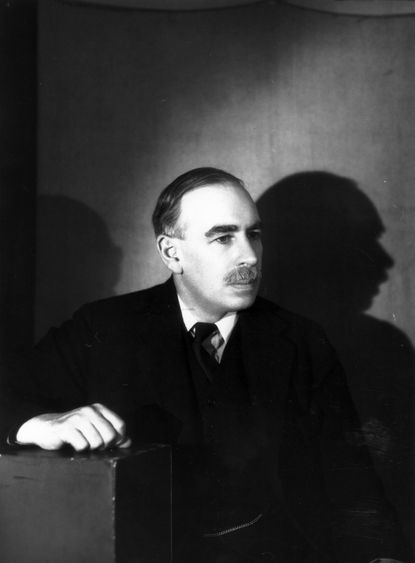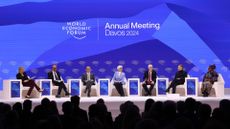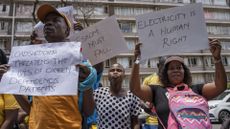How John Maynard Keynes' most radical idea could save the world
"Bancor," explained


As the Second World War was drawing to a close, the economic experts of the Allies met in a New Hampshire resort to try to hammer out an international monetary system that would help prevent a recurrence of the Great Depression. The ensuing debate centered around two main proposals, one from the British delegation and one from the American. John Maynard Keynes, the greatest economist of the 20th century, presented the British case while Harry Dexter White, one of FDR's key economic advisers, presented the American one.
Keynes lost on many key points. The result was the Bretton Woods system, named after the small town in which the conference was held. As part of the agreement, it also created what would later become the International Monetary Fund and the World Bank. That served as the system of managing international trade and currencies for nearly three decades. Today the IMF and World Bank survive, but Bretton Woods was broken in 1971 when Nixon suspended the convertibility of the dollar into gold.
Yet most of the problems that spurred the creation of Bretton Woods have since returned in only somewhat less dire form. It's worth returning to Keynes' original, much more ambitious idea for an international institution to manage the flow of goods and money around the globe.
Subscribe to The Week
Escape your echo chamber. Get the facts behind the news, plus analysis from multiple perspectives.

Sign up for The Week's Free Newsletters
From our morning news briefing to a weekly Good News Newsletter, get the best of The Week delivered directly to your inbox.
From our morning news briefing to a weekly Good News Newsletter, get the best of The Week delivered directly to your inbox.
The basic problem with international trade is that imbalances can develop: Some countries get big export surpluses, while others necessarily develop big trade deficits (since the world cannot be in surplus or deficit with itself). And because countries typically must borrow to finance trade deficits, it's a quick and easy recipe for a crash in those countries when their ability to take on more debt reaches its limit. It's not as bad for surplus countries, since they will not have a debt crisis or a collapse in the value of their currency, but they too will be hurt by the loss of export markets. This problem has haunted nations since well before the Industrial Revolution.
Nations like Germany with a large export surplus often portray it as resulting from their superior virtue and technical skill. But the fundamental reality of such a surplus is that it requires someone to buy the exports. As Yanis Varoufakis points out in his new book, without some sort of permanent mechanism to recycle that surplus back into deficit countries, the result will be eventual disaster. It's precisely what caused the initial economic crisis in Greece that is still ongoing.
Bretton Woods addressed this problem with a set of rather ad hoc measures. The dollar would be pegged to a particular amount of gold, and semi-fixed exchange rates for other currencies were to be fixed around that. In keeping with White's more orthodox economic views, all trade imbalances were to be solved on the deficit side. There was no limit to the surplus nations could build up (importantly, at the time the U.S. was a huge exporter), and the IMF was tasked with shoring up countries having serious trade deficit problems by enforcing austerity and tight money. (This would lead to repeated disaster for developing countries.)
Keynes' idea, by contrast, was substantially more ambitious. He proposed an overarching "International Clearing Union" that potentially every country in the world could join. It would create a new reserve currency, the "bancor," that could only be used for settling international accounts, and member nations would pay a membership quota in proportion to their total trade. Countries in surplus would receive bancor credit, while those in deficit would have a negative account.
Sign up for Today's Best Articles in your inbox
A free daily email with the biggest news stories of the day – and the best features from TheWeek.com
The union was also explicitly aimed at facilitating increased trade overall (also unlike Bretton Woods). And critically, it would incentivize nations to keep their trade balanced on both sides — surplus and deficit. Run too far into deficit, and a country would be required to devalue to reduce imports. But run too far into surplus, and a country's currency would be required to appreciate so as to increase imports. A bancor tax would also be levied at an increasing rate on anyone with a large trade imbalance.
There's much more to the story, but the fundamental idea is fairly simple. As Keynes wrote in his original proposal, the basic "principle is the necessary equality of credits and debits, of assets and liabilities. If no credits can be removed outside the clearing system but only transferred within it, the Union itself can never be in difficulties."
For the postwar generation, Bretton Woods worked tolerably well — and it certainly was a vast improvement on the prewar gold standard. But its mechanisms were far less legible, and required constant good-faith efforts from various nations, particularly Germany and the U.S., to work properly. More importantly, it relied on large American surpluses to soak up the huge aid that was being sent to Europe under the Marshall Plan, a goodly portion of which was used to buy American-made exports. When the U.S. moved to deficit, the system broke down within only a few years.
Keynes' plan, by contrast, would likely have had the flexibility to adapt to a massive 180 degree shift in the balance of trade. It is also far more transparent and comprehensible to average people, perhaps disrupting the excessive pride of surplus countries to some extent. And if it were to be created in the future, it would be under effective supervision from the member states. The vast carnage inflicted by the unaccountable, supranational European Central Bank is too stark to ignore.
It would undoubtedly take years and years to build and update Keynes proposal to where it might be implemented. But the problems it is designed to address will always keep cropping up. Perhaps after the eurozone implodes, the world will get another chance to do it right.
Create an account with the same email registered to your subscription to unlock access.
Ryan Cooper is a national correspondent at TheWeek.com. His work has appeared in the Washington Monthly, The New Republic, and the Washington Post.
-
 Today's political cartoons - April 21, 2024
Today's political cartoons - April 21, 2024Cartoons Sunday's cartoons - devilish decrees, biblical blunders, and more
By The Week US Published
-
 5 carefully selected cartoons about the Trump-Daniels jury selection process
5 carefully selected cartoons about the Trump-Daniels jury selection processCartoons Artists take on a stress-free life, rare peers, and more
By The Week US Published
-
 Loire Valley Lodges review: sleep, feast and revive in treetop luxury
Loire Valley Lodges review: sleep, feast and revive in treetop luxuryThe Week Recommends Forest hideaway offers chance to relax and reset in Michelin key-winning comfort
By Julia O'Driscoll, The Week UK Published
-
 Geopolitics and the economy in 2024
Geopolitics and the economy in 2024Talking Point The West is banking on a year of falling inflation. Don't rule out a shock
By The Week UK Published
-
 US-led price cap on Russian oil 'almost completely circumvented'
US-led price cap on Russian oil 'almost completely circumvented'Speed Read 'Almost none' of seaborne crude oil from Moscow stayed below $60 per barrel limit imposed by G7 and EU last year
By Harriet Marsden, The Week UK Published
-
 Mexico's Sinaloa cartel bans fentanyl, reportedly under pain of death
Mexico's Sinaloa cartel bans fentanyl, reportedly under pain of deathSpeed Read The top exporter of fentanyl to the U.S. is apparently looking to diversify as law enforcement turns up the heat
By Peter Weber, The Week US Published
-
 The threat posed by bonds to the global financial system
The threat posed by bonds to the global financial systemUnder The Radar The worst bear market in a century is unleashing huge strain on parts of the financial system
By The Week Staff Published
-
 China: a superpower’s slump
China: a superpower’s slumpThe Explainer After 40 years of explosive growth, China’s economy is now in deep distress — with no turnaround in sight
By The Week Staff Published
-
 Are Western sanctions working on Russia’s growing economy?
Are Western sanctions working on Russia’s growing economy?Today's Big Question IMF forecasts Russian growth but one expert says the West must be patient in bid to deter Putin
By Arion McNicoll Published
-
 South Africa’s energy crisis explained
South Africa’s energy crisis explainedfeature Electricity blackouts lead to rising crime and economic hardship and add to pressure on ANC
By The Week Staff Published
-
 India’s geopolitical aspirations in 2023
India’s geopolitical aspirations in 2023feature The emerging Asian superpower is showing ‘growing confidence’ on the world stage
By Chas Newkey-Burden Published